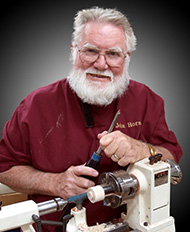

JOHN HORN |
“TAMING THE SKEW" by JOHN HORNStarting to use the skew is a real adventure for most turners if they try to do it on their own. The skew will absolutely give the best surface on the wood directly from the tool. While the skew provides a wonderful finish cut, it DEMANDS that the turner follow the rules for using the skew, or the heavy price of ugly catches and thread like spirals result in the most unwelcome places. While not as user friendly as some other tools, it is the most versatile chisel we have and it is the best tool for some cuts. During the hands-on class, of the twelve cuts the skew can produce, emphasis will be placed on the three most important cuts that every woodturner should master for every day turning. By attending a class to learn skew techniques under the watchful eye of an instructor, “a person does not have to re-invent the wheel”. Through the course of this session, making friends with the skew will be the goal rather than making it your enemy. To make a friend, a person must understand the needs of the other person. Likewise, learning what the skew needs from the turner is the major concern of the woodturner Skill Requirements: All Levels BiographyEducated as an instructor of high school musicians, John Horn has spent a major portion of his life teaching a variety of subjects from high school band and choir to adult computer applications. Now he teaches classes and one-on-one sessions on woodturning topics in his shop for beginning to intermediate turners. When he is not teaching and attending woodturning meetings, he stays busy turning contract jobs for corporations and individuals on one of his two Oneway wood lathes. A member of the AAW, he is active in both the Woodturners of North Texas and the Golden Triangle Woodturners |